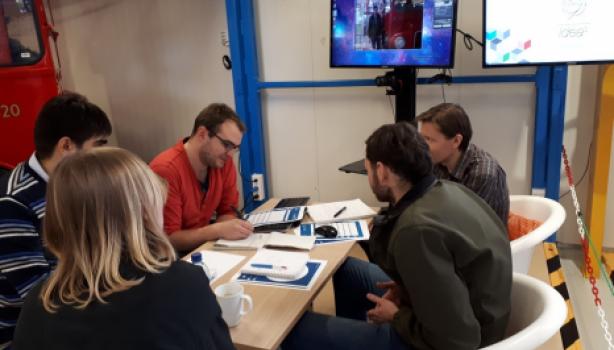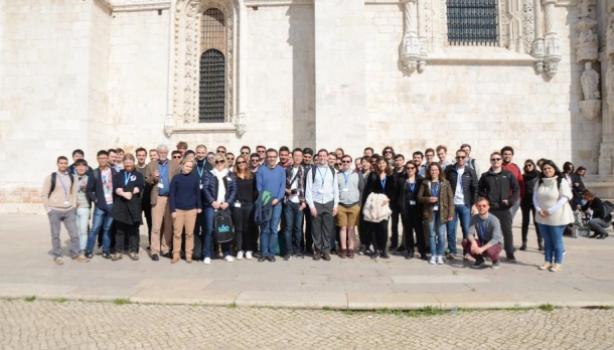Cryogenics and its applications took central stage during the EASISchool 2 that was held from the 30th of September to the 4th of October in two CEA sites, Paris-Saclay and Grenoble, France. Advancements in cryogenic technology has handed scientists and engineers the unique tools paving new ways in our study of the Universe but also finding applications that have revolutionized our way of living. Today, cryogenics finds its application in almost all modern accelerators for research in particle physics and in a broad range of domains including medical instruments, rocket and satellite science, electronics, manufacturing and food industry among others.
EASISchool 2 offered an intensive training program for the early-stage career researchers, following last year’s EASITrain’s summer school on superconductivity. The school provided training at doctoral level for about 40 students and researchers from all over the world. This is what really happened during the EASISchool autumn school. The scientific and technical topics of the school were selected to give the students the capacity to use, develop, and design the cryogenic instruments, needed for both research and industrial applications. The school focused on open R&D topics that offer the opportunity for collaboration between the academia and the industry while offering to EASITrain early-stage researchers a broad exposure to several companies.
The first day was devoted to cryogenics in the medical instruments, Magnetic Resonance Imaging (MRI) and proton-therapy, and to accelerator applications with presentations from experts on the challenges for superconducting magnets, and RF cavities. Speakers from CEA-Saclay, Varian Medical Systems, ZANON, Institut de Physique Nucléaire d’Orsay, and Research Instruments presented a broad spectrum of applications and lessons learned in the field. The importance of cryogenics for superconducting magnets not limited to particle physics was in the main focus during the second day. The increase of energy in accelerators over the past decades has led to challenging design of superconducting magnets for both accelerators and the associated detectors with LHC pushing accelerator magnet technology to its limits Superconducting magnets are under construction for the International Thermonuclear Experimental Reactor Programme (ITER) built in Cadarache, France. In both cases cryogenics is essential to reach the desired operating temperatures and maximize the performance of these machines. Moreover, ongoing R&D on high-temperature superconductivity, pulsating heat pipe, LNG transport (Gaztransport & Technigaz), and levitation were discussed. Finally, more innovative applications of cryogenics; from quantum computation (Oxford Instruments) to deep-space missions were covered on the afternoon of the second day. The visits of the world-largest MRI magnet (11.7T) at the Neuro-science laboratory and of the accelerator and cryo-magnetism laboratories at CEA-Saclay perfectly illustrated the school lectures.

The world-largest MRI magnet in its final location at the Neurospin laboratory, CEA Paris-Saclay
In the following days in Grenoble, EASISchool 2 took a deeper look into the space and aerospace applications of cryogenics with presentations from ESA, CEA-Grenoble, CNRS, Absolut System, and Air Liquide on different technologies developed to tackle the specific challenges of the space missions. The Planck mission that offered in 2013 the most precise map of the Cosmic Microwave Background radiation, and the MeteoSat satellite were two of the examples discussed during the sessions. The discussion continued in the afternoon with presentations from Air Liquide, Thales Alenia Space, and Ariane Group. Finally, the school covered large-scale cryogenic refrigeration and liquefaction domains, and finished with an inspiring talk on the management of research and innovation at Air Liquide.

EASISchool 2 participants at the top of the beautiful site of the Bastille summit, Grenoble.
During the school in Grenoble, participants also had a unique chance to visit Air Liquide Advanced Technologies headquarters and take a guided tour in the space application clean room, the turbo-expanders test facility and the large helium liquefier/refrigerator/cryolines construction workshop. Moreover, participants had a chance to visit the Cryogenic Laboratories of CEA-Grenoble, France’s National High Magnetic Field laboratory and the European Synchrotron Radiation Facility in Grenoble, learning about the diverse research programs in condensed and living matter using the world's most intense X-ray source.

Visit to the turbo-expander test bench at Air Liquide Advanced Technologies factory
EASISchool 2 also featured satellite public events including the opening of the public travelling exhibition “The Code of the Universe”, installed for three months at the MINATEC site at Grenoble, France. The photographic exhibition opened on the 18th of September followed by a public lecture of the FCC-ee co-leader, Prof. Alain Blondel (University of Geneva) who discussed the challenges of designing the Future Circular Collider as humanity’s next adventure. The exhibition was also part of the “Grenoble Fête de la Science 2019” giving the opportunity to thousands of visitors to visit it and learn more about the technologies needed to progress in fundamental physics. Moreover, Jakub Tkaczuk, a MSCA EASITrain fellow working in CEA-Grenoble, offered guided visits for local primary and high schools. A public conference “La cryogénie au service des découvertes scientifiques” (Cryogenics for scientific discoveries) concluded this EASITrain animation at the “Grenoble Fête de la Science 2019”.

EASITrain animation around the exhibition “The Code of the Universe” at the French “Fête de la Science 2019”on the 10th and 12th of October 2019 at MINATEC, Grenoble. Jakub Tkaczuk (MSCA Early Stage Researcher) initiated more than 400 students from primary and high schools to discover the superconducting and cryogenic applications.
The scientific and social program of the school offered valuable insights into novel approaches in cryogenics, and valuable networking with experts from different fields. Constructive discussions during the school proved that challenges become manageable from different angles and creative solutions sometimes emerge. Stay tuned for the next EASISchool that will take place in September 2020 in Genova, Italy.


